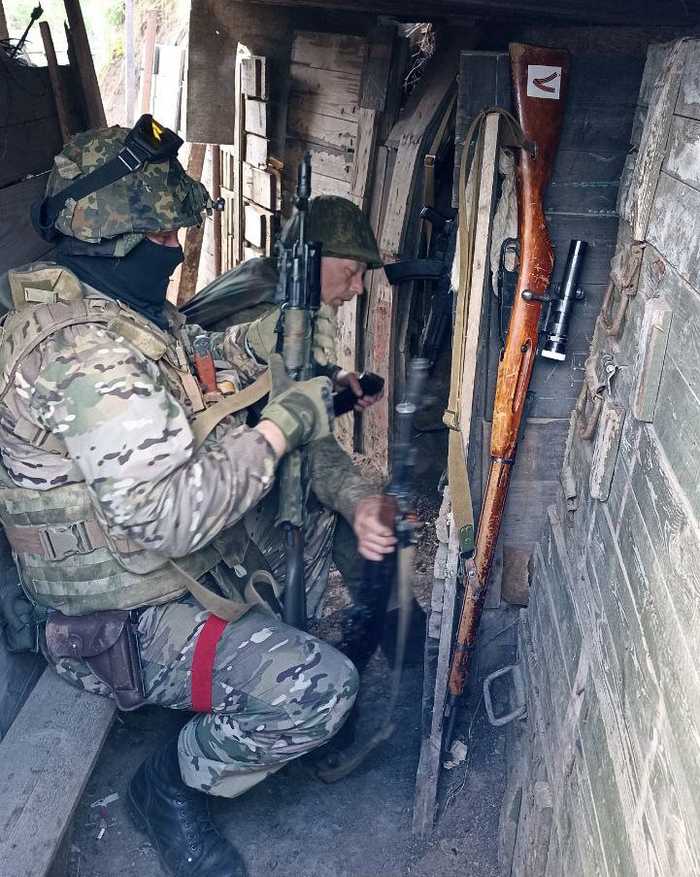Published 11:34 IST, May 27th 2024
Russia's deployment of Mosin Nagant to conscripts, including separatist militia in Mariupol, showcases a blend of historical relics and advanced arms.
Advertisement
Kyiv: The reappearance of Mosin Nagant rifles in Ukraine has drawn significant attention, particularly as these vintage firearms contrast sharply with the modern weaponry typically seen on today's battlefields. Specifically, the Mosin Nagant M91/30 variants, equipped with original PU 3.5x21 scopes, have been identified among the arsenal. This model was the Soviet Union's standard-issue infantry rifle from 1930 until it was replaced in 1963 by the SVD.
The Mosin Nagant, a five-shot, bolt-action rifle with an internal magazine, was officially known as the 3-line rifle M1891. Despite being developed over a century ago, from 1882 to 1891, it remains chambered for its original 7.62×54mmR cartridge. Its historical significance is underscored by its extensive production, with over 37 million units manufactured, making it one of the most mass-produced military bolt-action rifles in history.
Advertisement
Mosin Nagant: A Historical Relic in Modern Warfare
The Mosin Nagant has been used by various states' armed forces since the Russian Empire and the Soviet Union, continuing to see action in global conflicts up to the present day. Despite its age, the rifle is still found on modern battlefields. Recently, Russia has issued Mosin Nagant to conscripts from occupied regions of Donbas and to conscripted Russian civilians during Vladimir Putin's broader mobilization efforts in the 2022 invasion of Ukraine.

This deployment strategy seems practical from a utilitarian viewpoint, particularly for equipping personnel who are unlikely to engage in direct combat but still require firearms. Reports indicate that these rifles are being used by Russian-backed separatist militia at checkpoints in Mariupol, providing a stark juxtaposition to the more advanced weaponry in the conflict.
Advertisement

The continued use of the Mosin Nagant, especially after its notable role in the Syrian conflict, demonstrates its enduring utility when suitably updated. However, seeing these relics alongside the latest AK iterations, contemporary night vision equipment, and the high-tech digital warfare of today is striking. Questions arise about the availability of more modern firearms like the AKM for these combatants.
Recent Battlefield Developments: Modern Munitions in Use
In another development, the air-launched GBU-39 Small Diameter Bomb (SDB) has been confirmed in use by Ukraine. Previously, Ukraine's arsenal was known to include the Ground Launched Small Diameter Bomb (GLSDB), but its combat effectiveness has recently come under scrutiny. According to a U.S. official, nearly 90 per cent of air-launched SDBs have successfully hit their targets, demonstrating resilience against jamming.
Advertisement
-1716788295834.webp)
The SDB's smaller surface area makes it less detectable and interceptable by Russian air defence systems, as per Ukrainian assessments. However, the GLSDB, which combines the GBU-39/B SDB with a rocket booster motor from a 227mm-caliber M26 artillery rocket, has proven less effective. Ukrainian officials have highlighted the need for design modifications before further deliveries.
The ability of the GLSDB to strike targets up to 94 miles away offers significant tactical advantages, but its current performance issues must be addressed to enhance its reliability. The contrasting success rates of the air-launched SDB and the surface-launched GLSDB underscore the challenges and complexities of modern warfare.
Advertisement
The presence of both cutting-edge munitions like the SDB and historic rifles like the Mosin Nagant in the Ukraine conflict paints a complex picture of military logistics and strategy. The Mosin Nagant's enduring presence on the battlefield, alongside advanced weapons, highlights both its historical significance and the diverse nature of modern combat forces.
As the conflict continues, the juxtaposition of these weapons from different eras underscores the unique and evolving nature of warfare. The blending of historical firearms with contemporary military technology serves as a reminder of the continuous adaptation required in the face of changing combat scenarios.
Advertisement
11:34 IST, May 27th 2024